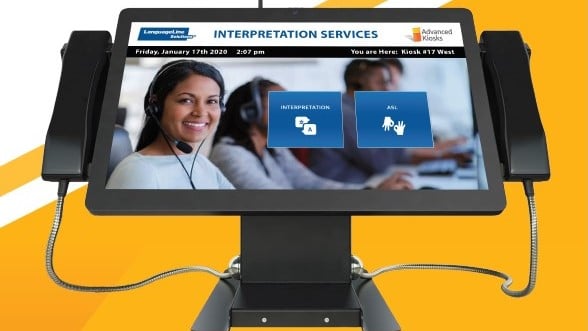
Advanced Kiosks, an industry-leading supplier of computer self-service kiosks, announced a partnership with LanguageLine Solutions® to provide video interpretation services for 41 languages, including American Sign Language (ASL). Audio-only interpretation is provided in more than 240 languages.
In just seconds, the new service will connect directly to LanguageLine’s team of more than 20,000 professional interpreters. The language-access service is offered through a kiosk system created with an innovative mix of touch screen technology and video conferencing capabilities.
Both companies have a long history of using technology to bridge communication gaps. LanguageLine has been providing interpretation and translation services for more than 40 years, working closely with the Limited English Proficient and the Deaf and Hard of Hearing communities. Advanced Kiosks has more than 20 years of experience creating ADA compliant self-service kiosks, allowing equal access to goods and services offered by their clients.
READ MORE: Kiosk Program Provides Limited English Speakers with Virtual Care
The first joint product offers a touch-screen kiosk to facilitate one-touch, on-demand language access. A user of the device may select a language and their preference for audio or video, all without needing to look up any web addresses or phone numbers.
We spoke with Jeff LeBlanc, Director of User Experience at Advanced Kiosks, about the collaboration and the expanding demand for self-service.
Has self-service been growing in popularity?
Yes. Places are looking for efficiency and increased throughput via automation. They’re not necessarily reducing headcount, but they are increasing efficiency. McDonald’s is a familiar example. They had customers enter their orders on a kiosk, which enabled the person who had once been behind the counter to do other things.
How much does the potential usefulness of kiosks grow when you add the availability of 240+ languages?
Healthcare organizations and government agencies are required to provide meaningful access to language services. By solving the language challenge, now kiosks can be made broadly available in these settings. Likewise, commercial businesses that have multilingual audiences may also be more intrigued now that professional interpretation is available in more than 240 languages.
How would you describe your Interpretation Kiosk?
The Interpretation Kiosk is a touchscreen kiosk with dual handsets for privacy. The English speaker and non English speaker can each pick up a handset and easily access a LanguageLine interpreter through the touchscreen. In addition to audio-only interpretation being available in more than240 languages, there is also video interpretation in 41 languages, including American Sign Language for the Deaf and Hard of Hearing community.
We also have a model without the handsets for instances in which privacy is not an issue. In that instance, we have a similar model with a microphone and speakers.
READ MORE: Three Steps to Successfully Implementing Video Interpreting
Our standard model has a 22-inch screen, which really enhances the overall experience. It’s much more visual than an iPad, for example.
We understand you’re also developing a “touchless” kiosk, a la “Minority Report,” where the hand does not actually make contact with the screen.
We’re in a touchless world, so we’re excited about it. The touchless kiosk uses a depth-sensor camera that allows the user to function at a distance from the machine. As the user points toward the screen, it registers a click.
Getting back to the kiosks you currently have available, where do you see them being most useful?
It will go anywhere there is a need for a static machine – one that is not portable and is bolted down. We’re talking about lobbies, reception desks, nurses’ desks …
Can you give us an example of a deployment that shows your technology in action?
San Francisco International Airport is a worldwide hub and they prioritize access. We created a kiosk that functions as a remote help desk. Let’s say that an international traveler needs help and wants to talk with someone at the airport desk. The traveler walks up to the desk and picks up a handset; meanwhile, the desk agent has a headset they plug into a jack. An interpreter comes on the line in the appropriate language and soon everyone is having a conversation.

